2016 NISSAN NV200 service
[x] Cancel search: servicePage 281 of 312

Replacing wheels and tires
When replacing a tire, use the same size, tread
design, speed rating and load carrying capacity
as originally equipped. Recommended types and
sizes are shown in “Wheels and tires” in the
“Technical and consumer information” section of
this manual.
WARNING
●The use of tires other than those recom-
mended or the mixed use of tires of
different brands, construction (bias,
bias-belted or radial) , or tread patterns
can adversely affect the ride, braking,
handling, VDC system, ground clear-
ance, body-to-tire clearance, tire chain
clearance, speedometer calibration,
headlight aim and bumper height.
Some of these effects may lead to acci-
dents and could result in serious per-
sonal injury.
● If your vehicle was originally equipped
with four tires that were the same size
and you are only replacing two of the
four tires, install the new tires on the
rear axle. Placing new tires on the front
axle may cause loss of vehicle control in
some driving conditions and cause an
accident and personal injury. ●
If the wheels are changed for any rea-
son, always replace with wheels which
have the same off-set dimension.
Wheels of a different off-set could
cause premature tire wear, degrade ve-
hicle handling characteristics, affect the
VDC system and/or interference with
the brake discs. Such interference can
lead to decreased braking efficiency
and/or early brake pad wear. For addi-
tional information, refer to “Wheels and
tires” in the “Technical and consumer
information” section of this manual for
wheel off-set dimensions.
● When a spare tire is mounted or a wheel
is replaced, tire pressure will not be
indicated, the TPMS will not function
and the low tire pressure warning light
will flash for approximately 1 minute.
The light will remain on after 1 minute.
Contact your NISSAN dealer as soon as
possible for tire replacement and/or
system resetting.
● Replacing tires with those not originally
specified by NISSAN could affect the
proper operation of the TPMS. ●
Do not install a damaged or deformed
wheel or tire even if it has been re-
paired. Such wheels or tires could have
structural damage and could fail with-
out warning.
● The use of retread tires is not
recommended.
● For additional information regarding
tires, refer to “Important Tire Safety In-
formation” in the Warranty Information
Booklet.
Wheel balance
Unbalanced wheels may affect vehicle handling
and tire life. Even with regular use, wheels can get
out of balance. Therefore, they should be bal-
anced as required.
Wheel balance service should be per-
formed with the wheels off the vehicle.
Spin balancing the wheels on the vehicle
could lead to mechanical damage.
● For additional information regarding
tires, refer to “Important Tire Safety
Information” in the Warranty Informa-
tion Booklet.
8-42Maintenance and do-it-yourself
Page 284 of 312
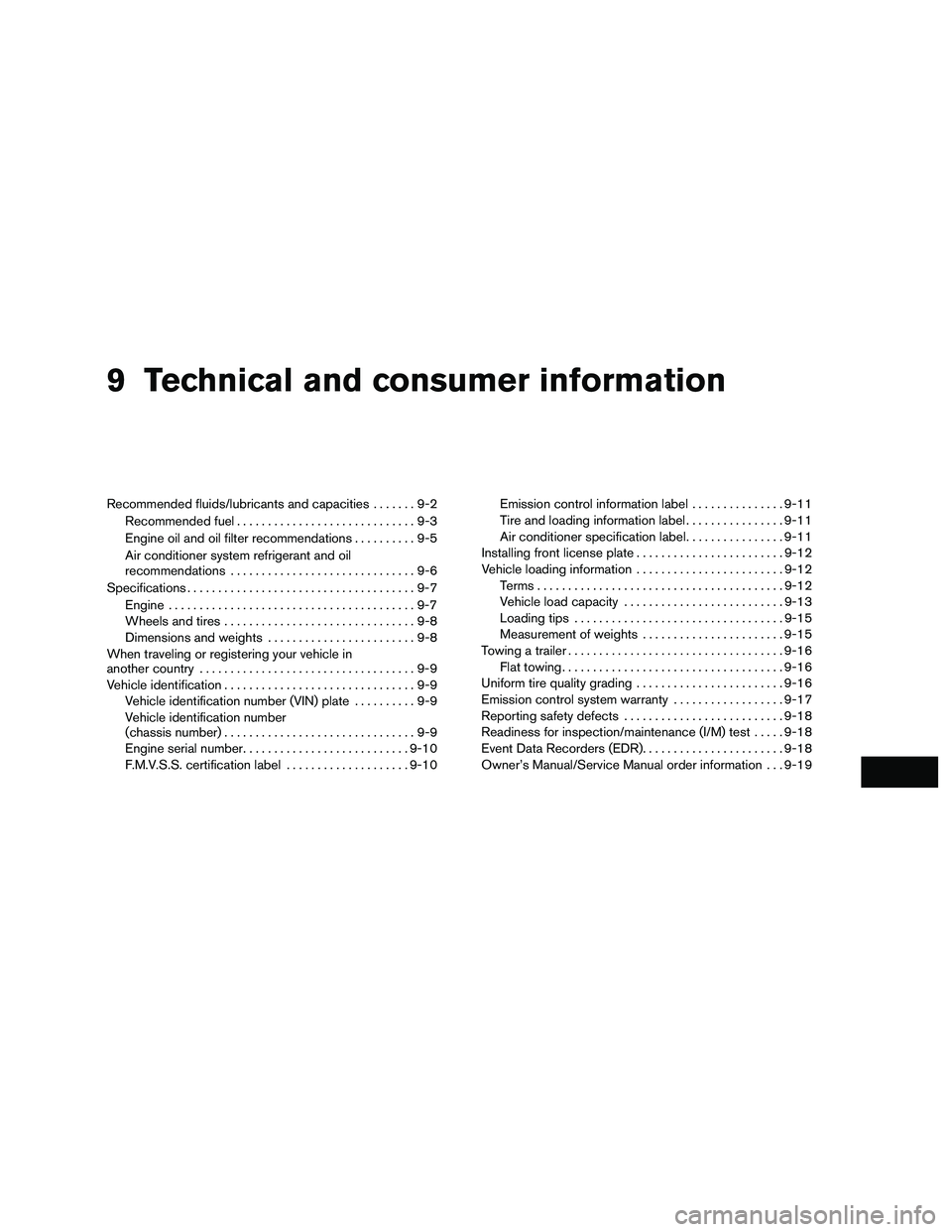
9 Technical and consumer information
Recommended fluids/lubricants and capacities.......9-2
Recommended fuel .............................9-3
Engine oil and oil filter recommendations ..........9-5
Air conditioner system refrigerant and oil
recommendations ..............................9-6
Specifications .....................................9-7
Engine ........................................9-7
Wheels and tires ...............................9-8
Dimensions and weights ........................9-8
When traveling or registering your vehicle in
another country ...................................9-9
Vehicle identification ...............................9-9
Vehicle identification number (VIN) plate ..........9-9
Vehicle identification number
(chassis number) ...............................9-9
Engine serial number ........................... 9-10
F.M.V.S.S. certification label ....................9-10Emission control information label
...............9-11
Tire and loading information label ................9-11
Air conditioner specification label ................9-11
Installing front license plate ........................9-12
Vehicle loading information ........................9-12
Terms ........................................ 9-12
Vehicle load capacity .......................... 9-13
Loading tips .................................. 9-15
Measurement of weights .......................9-15
Towing a trailer ................................... 9-16
Flat towing .................................... 9-16
Uniform tire quality grading ........................9-16
Emission control system warranty ..................9-17
Reporting safety defects .......................... 9-18
Readiness for inspection/maintenance (I/M) test .....9-18
Event Data Recorders (EDR) .......................9-18
Owner’s Manual/Service Manual order information . . . 9-19
Page 286 of 312
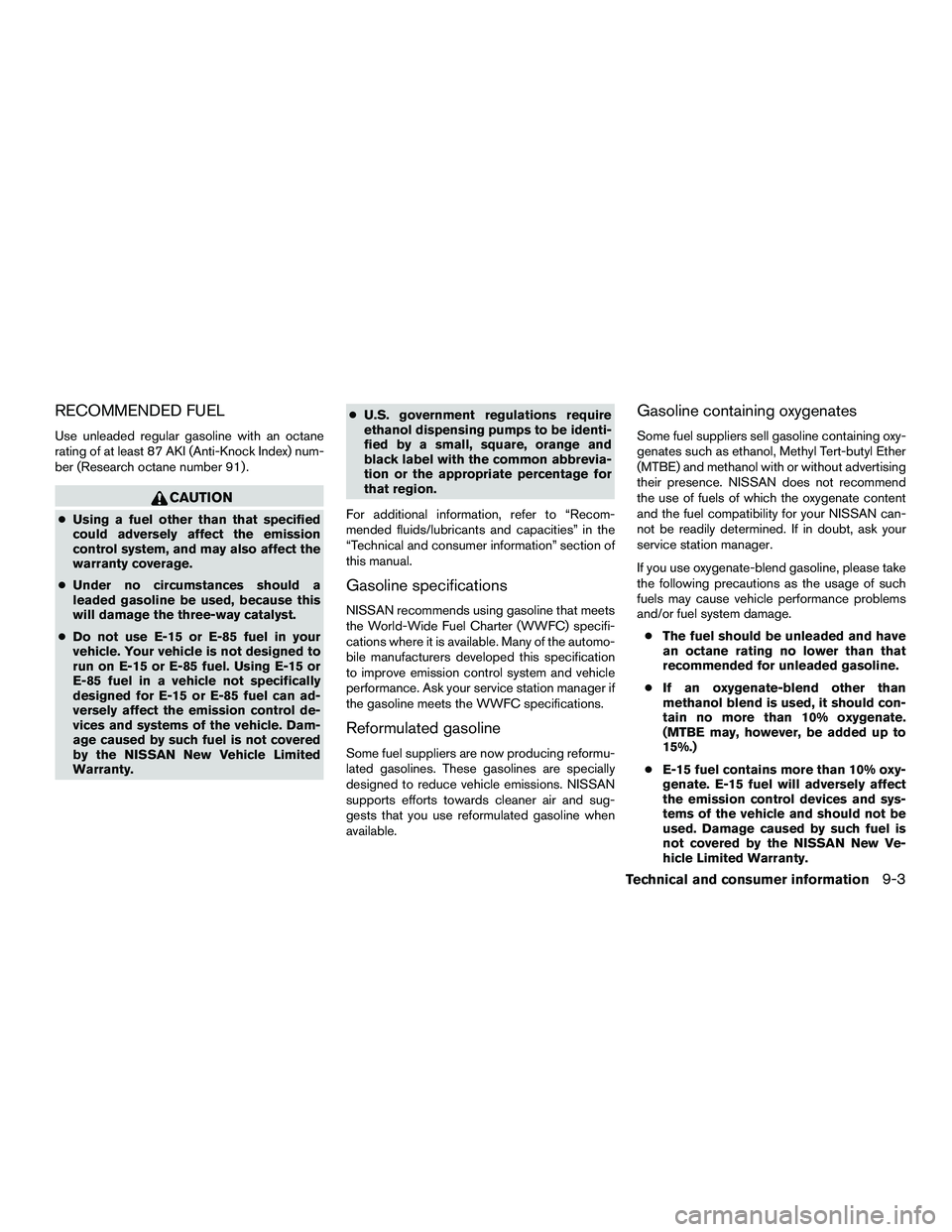
RECOMMENDED FUEL
Use unleaded regular gasoline with an octane
rating of at least 87 AKI (Anti-Knock Index) num-
ber (Research octane number 91) .
CAUTION
●Using a fuel other than that specified
could adversely affect the emission
control system, and may also affect the
warranty coverage.
● Under no circumstances should a
leaded gasoline be used, because this
will damage the three-way catalyst.
● Do not use E-15 or E-85 fuel in your
vehicle. Your vehicle is not designed to
run on E-15 or E-85 fuel. Using E-15 or
E-85 fuel in a vehicle not specifically
designed for E-15 or E-85 fuel can ad-
versely affect the emission control de-
vices and systems of the vehicle. Dam-
age caused by such fuel is not covered
by the NISSAN New Vehicle Limited
Warranty. ●
U.S. government regulations require
ethanol dispensing pumps to be identi-
fied by a small, square, orange and
black label with the common abbrevia-
tion or the appropriate percentage for
that region.
For additional information, refer to “Recom-
mended fluids/lubricants and capacities” in the
“Technical and consumer information” section of
this manual.
Gasoline specifications
NISSAN recommends using gasoline that meets
the World-Wide Fuel Charter (WWFC) specifi-
cations where it is available. Many of the automo-
bile manufacturers developed this specification
to improve emission control system and vehicle
performance. Ask your service station manager if
the gasoline meets the WWFC specifications.
Reformulated gasoline
Some fuel suppliers are now producing reformu-
lated gasolines. These gasolines are specially
designed to reduce vehicle emissions. NISSAN
supports efforts towards cleaner air and sug-
gests that you use reformulated gasoline when
available.
Gasoline containing oxygenates
Some fuel suppliers sell gasoline containing oxy-
genates such as ethanol, Methyl Tert-butyl Ether
(MTBE) and methanol with or without advertising
their presence. NISSAN does not recommend
the use of fuels of which the oxygenate content
and the fuel compatibility for your NISSAN can-
not be readily determined. If in doubt, ask your
service station manager.
If you use oxygenate-blend gasoline, please take
the following precautions as the usage of such
fuels may cause vehicle performance problems
and/or fuel system damage. ● The fuel should be unleaded and have
an octane rating no lower than that
recommended for unleaded gasoline.
● If an oxygenate-blend other than
methanol blend is used, it should con-
tain no more than 10% oxygenate.
(MTBE may, however, be added up to
15%.)
● E-15 fuel contains more than 10% oxy-
genate. E-15 fuel will adversely affect
the emission control devices and sys-
tems of the vehicle and should not be
used. Damage caused by such fuel is
not covered by the NISSAN New Ve-
hicle Limited Warranty.
Technical and consumer information9-3
Page 289 of 312
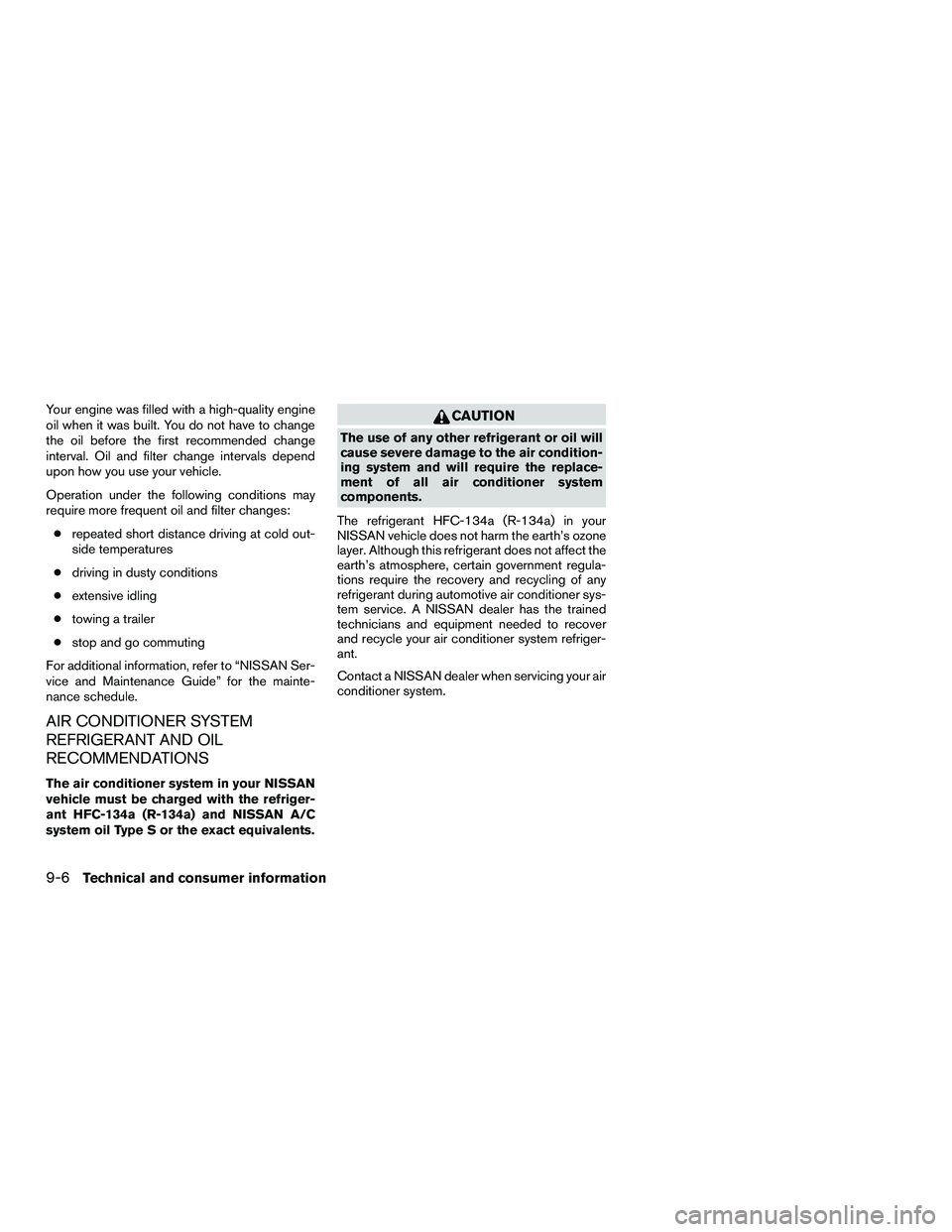
Your engine was filled with a high-quality engine
oil when it was built. You do not have to change
the oil before the first recommended change
interval. Oil and filter change intervals depend
upon how you use your vehicle.
Operation under the following conditions may
require more frequent oil and filter changes:● repeated short distance driving at cold out-
side temperatures
● driving in dusty conditions
● extensive idling
● towing a trailer
● stop and go commuting
For additional information, refer to “NISSAN Ser-
vice and Maintenance Guide” for the mainte-
nance schedule.
AIR CONDITIONER SYSTEM
REFRIGERANT AND OIL
RECOMMENDATIONS
The air conditioner system in your NISSAN
vehicle must be charged with the refriger-
ant HFC-134a (R-134a) and NISSAN A/C
system oil Type S or the exact equivalents.
CAUTION
The use of any other refrigerant or oil will
cause severe damage to the air condition-
ing system and will require the replace-
ment of all air conditioner system
components.
The refrigerant HFC-134a (R-134a) in your
NISSAN vehicle does not harm the earth’s ozone
layer. Although this refrigerant does not affect the
earth’s atmosphere, certain government regula-
tions require the recovery and recycling of any
refrigerant during automotive air conditioner sys-
tem service. A NISSAN dealer has the trained
technicians and equipment needed to recover
and recycle your air conditioner system refriger-
ant.
Contact a NISSAN dealer when servicing your air
conditioner system.
9-6Technical and consumer information
Page 299 of 312
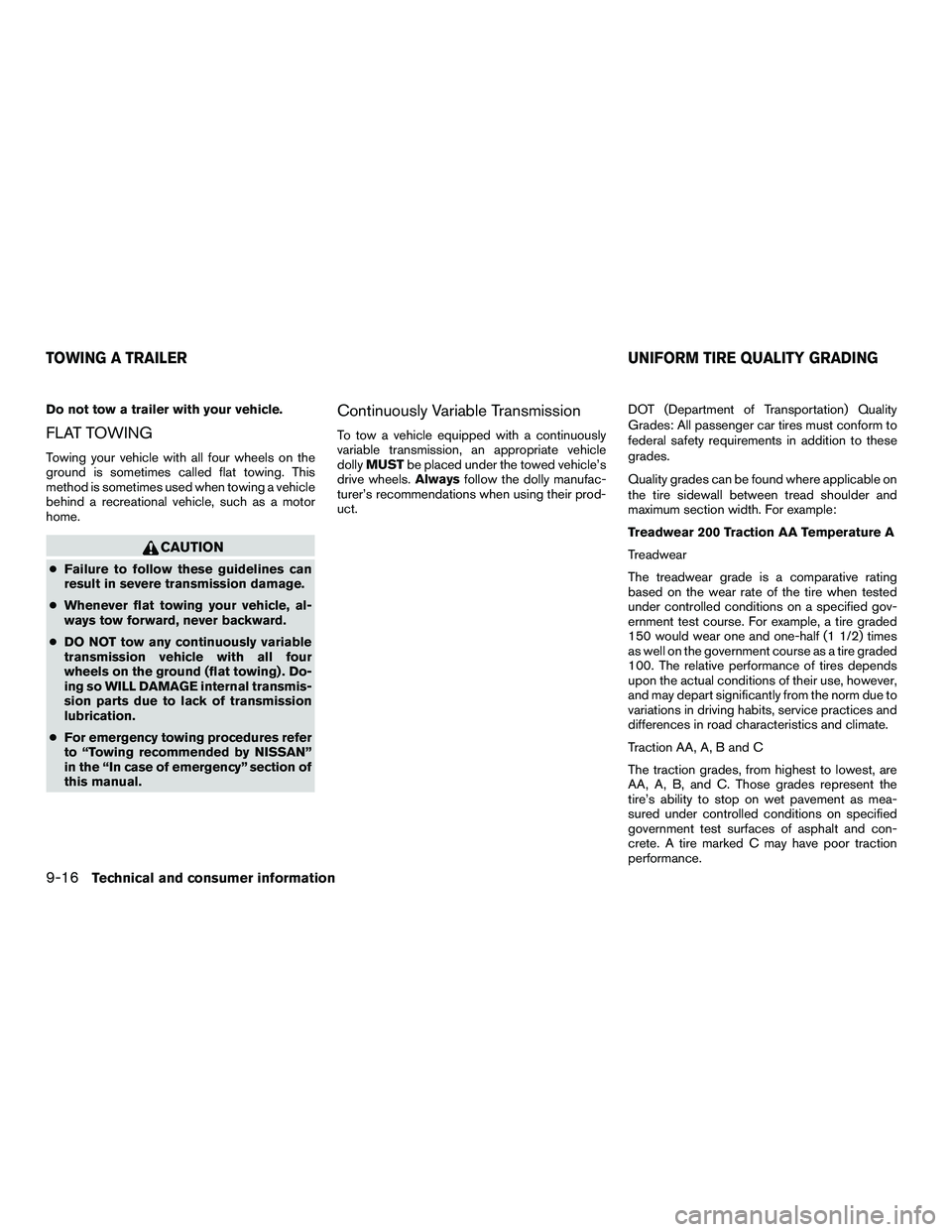
Do not tow a trailer with your vehicle.
FLAT TOWING
Towing your vehicle with all four wheels on the
ground is sometimes called flat towing. This
method is sometimes used when towing a vehicle
behind a recreational vehicle, such as a motor
home.
CAUTION
●Failure to follow these guidelines can
result in severe transmission damage.
● Whenever flat towing your vehicle, al-
ways tow forward, never backward.
● DO NOT tow any continuously variable
transmission vehicle with all four
wheels on the ground (flat towing) . Do-
ing so WILL DAMAGE internal transmis-
sion parts due to lack of transmission
lubrication.
● For emergency towing procedures refer
to “Towing recommended by NISSAN”
in the “In case of emergency” section of
this manual.
Continuously Variable Transmission
To tow a vehicle equipped with a continuously
variable transmission, an appropriate vehicle
dolly MUST be placed under the towed vehicle’s
drive wheels. Alwaysfollow the dolly manufac-
turer’s recommendations when using their prod-
uct. DOT (Department of Transportation) Quality
Grades: All passenger car tires must conform to
federal safety requirements in addition to these
grades.
Quality grades can be found where applicable on
the tire sidewall between tread shoulder and
maximum section width. For example:
Treadwear 200 Traction AA Temperature A
Treadwear
The treadwear grade is a comparative rating
based on the wear rate of the tire when tested
under controlled conditions on a specified gov-
ernment test course. For example, a tire graded
150 would wear one and one-half (1 1/2) times
as well on the government course as a tire graded
100. The relative performance of tires depends
upon the actual conditions of their use, however,
and may depart significantly from the norm due to
variations in driving habits, service practices and
differences in road characteristics and climate.
Traction AA, A, B and C
The traction grades, from highest to lowest, are
AA, A, B, and C. Those grades represent the
tire’s ability to stop on wet pavement as mea-
sured under controlled conditions on specified
government test surfaces of asphalt and con-
crete. A tire marked C may have poor traction
performance.
TOWING A TRAILER
UNIFORM TIRE QUALITY GRADING
9-16Technical and consumer information
Page 302 of 312
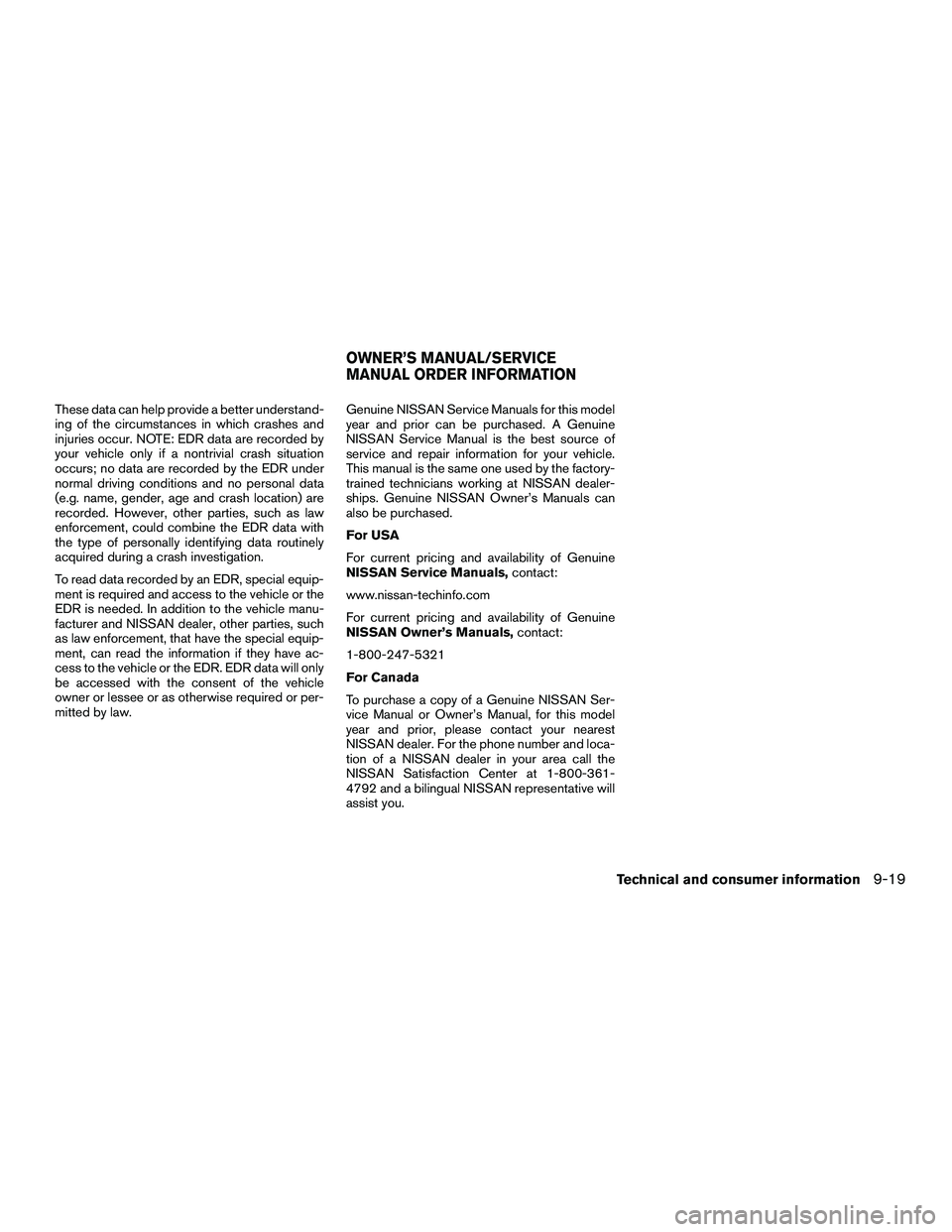
These data can help provide a better understand-
ing of the circumstances in which crashes and
injuries occur. NOTE: EDR data are recorded by
your vehicle only if a nontrivial crash situation
occurs; no data are recorded by the EDR under
normal driving conditions and no personal data
(e.g. name, gender, age and crash location) are
recorded. However, other parties, such as law
enforcement, could combine the EDR data with
the type of personally identifying data routinely
acquired during a crash investigation.
To read data recorded by an EDR, special equip-
ment is required and access to the vehicle or the
EDR is needed. In addition to the vehicle manu-
facturer and NISSAN dealer, other parties, such
as law enforcement, that have the special equip-
ment, can read the information if they have ac-
cess to the vehicle or the EDR. EDR data will only
be accessed with the consent of the vehicle
owner or lessee or as otherwise required or per-
mitted by law.Genuine NISSAN Service Manuals for this model
year and prior can be purchased. A Genuine
NISSAN Service Manual is the best source of
service and repair information for your vehicle.
This manual is the same one used by the factory-
trained technicians working at NISSAN dealer-
ships. Genuine NISSAN Owner’s Manuals can
also be purchased.
For USA
For current pricing and availability of Genuine
NISSAN Service Manuals,
contact:
www.nissan-techinfo.com
For current pricing and availability of Genuine
NISSAN Owner’s Manuals, contact:
1-800-247-5321
For Canada
To purchase a copy of a Genuine NISSAN Ser-
vice Manual or Owner’s Manual, for this model
year and prior, please contact your nearest
NISSAN dealer. For the phone number and loca-
tion of a NISSAN dealer in your area call the
NISSAN Satisfaction Center at 1-800-361-
4792 and a bilingual NISSAN representative will
assist you.
OWNER’S MANUAL/SERVICE
MANUAL ORDER INFORMATION
Technical and consumer information9-19
Page 307 of 312
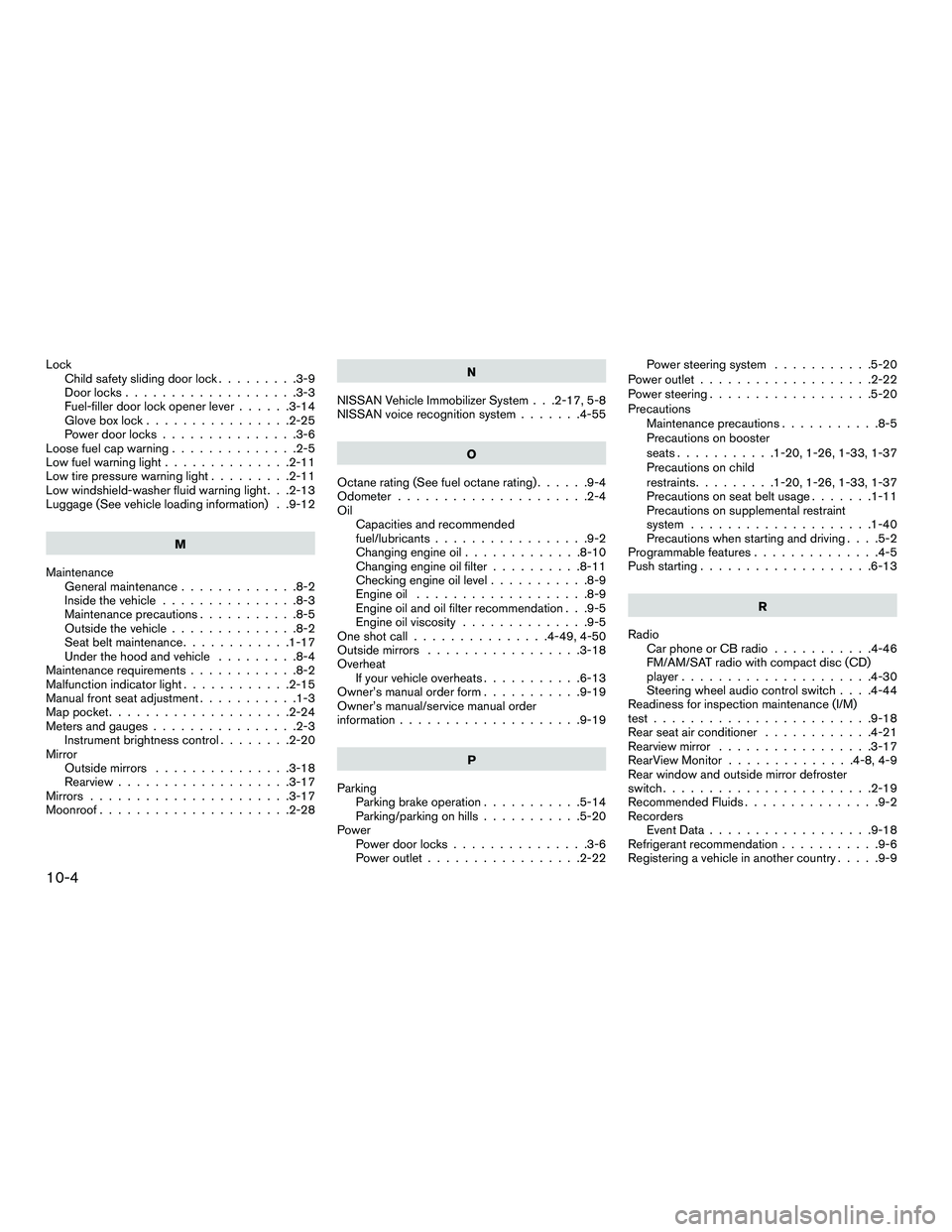
LockChild safety sliding door lock .........3-9
Door locks ...................3-3
Fuel-filler door lock opener lever ......3-14
Gloveboxlock................2-25
Power door locks ...............3-6
Loose fuel cap warning ..............2-5
Lowfuelwarninglight..............2-11
Low tire pressure warning light .........2-11
Low windshield-washer fluid warning light . . .2-13
Luggage (See vehicle loading information) . .9-12
M
Maintenance Generalmaintenance.............8-2
Insidethevehicle...............8-3
Maintenanceprecautions...........8-5
Outsidethevehicle..............8-2
Seat belt maintenance ............1-17
Under the hood and vehicle .........8-4
Maintenance requirements ............8-2
Malfunctionindicatorlight............2-15
Manual front seat adjustment ...........1-3
Map pocket ....................2-24
Meters and gauges ................2-3
Instrument brightness control ........2-20
Mirror Outside mirrors ...............3-18
Rearview ...................3-17
Mirrors ......................3-17
Moonroof.....................2-28 N
NISSAN Vehicle Immobilizer System . . .2-17, 5-8
NISSAN voice recognition system .......4-55
O
Octane rating (See fuel octane rating) ......9-4
Odometer .....................2-4
Oil Capacities and recommended
fuel/lubricants .................9-2
Changingengineoil.............8-10
Changing engine oil filter ..........8-11
Checking engine oil level ...........8-9
Engineoil ...................8-9
Engine oil and oil filter recommendation . . .9-5
Engine oil viscosity ..............9-5
Oneshotcall...............4-49,4-50
Outside mirrors .................3-18
Overheat If your vehicle overheats ...........6-13
Owner’s manual order form ...........9-19
Owner’s manual/service manual order
information ....................9-19
P
Parking Parking brake operation ...........5-14
Parking/parking on hills ...........5-20
Power Power door locks ...............3-6
Power outlet .................2-22 Power steering system
...........5-20
Poweroutlet...................2-22
Power steering ..................5-20
Precautions Maintenance precautions ...........8-5
Precautions on booster
seats...........1-20,1-26,1-33,1-37
Precautions on child
restraints .........1-20,1-26,1-33,1-37
Precautionsonseatbeltusage.......1-11
Precautions on supplemental restraint
system ....................1-40
Precautions when starting and driving ....5-2
Programmable features ..............4-5
Push starting ...................6-13
R
Radio CarphoneorCBradio ...........4-46
FM/AM/SAT radio with compact disc (CD)
player.....................4-30
Steering wheel audio control switch ....4-44
Readiness for inspection maintenance (I/M)
test........................9-18
Rear seat air conditioner ............4-21
Rearview mirror .................3-17
RearView
Monitor ..............4-8,4-9
Rear window and outside mirror defroster
switch.......................2-19
Recommended Fluids ...............9-2
Recorders EventData..................9-18
Refrigerant recommendation ...........9-6
Registering a vehicle in another country .....9-9
10-4
Page 308 of 312

Remote keyless entry system...........3-9
Reporting safety defects (US only) .......9-18
S
Safety Child safety sliding door lock .........3-9
Childseatbelts.....1-20,1-26,1-33,1-37
Reporting safety defects (US only) .....9-18
Seat adjustment Front manual seat adjustment ........1-3
Seat belt Child safety ..................1-18
Infantsandsmallchildren..........1-19
InjuredPerson................1-14
Largerchildren................1-19
Precautionsonseatbeltusage.......1-11
Pregnant women ...............1-14
Seat belt extenders .............1-17
Seat belt maintenance ............1-17
Seat belts ................1-11,7-5
Shoulder belt height adjustment ......1-17
Three-point type with retractor .......1-14
Seat belt extenders ...............1-17
Seatbeltwarninglight..........1-14,2-13
Seats Adjustment ...................1-2
Frontseats...................1-2
Manual front seat adjustment .........1-3
Seats/floor mats ..................7-4
Security indicator light ..............2-15
Security system (NISSAN Vehicle Immobilizer
System) , engine start ...........2-17,5-8
Self-adjusting brakes ..............8-19
Service manual order form ...........9-19Servicing air conditioner
.............4-22
Setting button ...................4-5
Shifting Continuously Variable Transmission
(CVT) .....................5-11
Shoulder belt height adjustment ........1-17
Sliding door Manual sliding door ..............3-6
Sliding door locks Child safety sliding door locks ........3-9
Spark plug replacement .............8-17
Sparkplugs ...................8-17
Specifications ...................9-7
Speedometer ...................2-4
SRS warning label ................1-57
Stability control .................5-22
Starting Before starting the engine ..........5-9
Jump starting .............6-11,8-15
Precautions when starting and driving ....5-2
Push starting .................6-13
Starting the engine ..............5-9
Starting the engine ................5-9
Steering Power steering system ...........5-20
Tilting steering wheel ............3-16
Steering wheel ..................3-16
Steering wheel audio control switch ......4-44
Stoplight.....................8-29
Storage......................2-23
Storage tray ...................2-24
Sunroof ......................2-28
Sunroof (see Moonroof) .............2-28
Sun visors ....................3-17
Supplemental air bag warning labels ......1-57
Supplemental
air bag warning light . . .1-58, 2-14 Supplemental front impact air bag system . . .1-48
Supplemental restraint system
Information and warning labels .......1-57
Precautions on supplemental restraint
system ....................1-40
Supplemental restraint system
(Supplemental air bag system) .........1-40
Switch Automatic power window switch ......2-26
Hazard warning flasher switch ........6-2
Headlightandturnsignalswitch......2-19
Headlight control switch ..........2-19
Ignition switch .................5-7
Instrument brightness control ........2-20
Powerdoorlockswitch............3-6
Rear window and outside mirror defroster
switch.....................2-19
Turnsignalswitch..............2-21
Vehicle dynamic control (VDC) off
switch.....................2-22
Wiperandwasherswitch..........2-18
T
Tachometer ....................2-6
Theft (NISSAN Vehicle Immobilizer System) ,
enginestart.................2-17,5-8
Three-way catalyst ................5-2
Tilting steering wheel ..............3-16
Tire Flat tire .....................6-2
Tire and Loading Information label .....9-11
Tirechains..................8-40
Tirepressure.................8-33
Tire rotation..................8-40
10-5